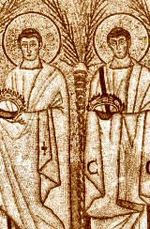
Butler's Lives of the Saints offers this on these two early martyrs:
"THE SAINTS whose victory the church commemorates on this day are honoured among the most illustrious martyrs that ennobled Rome with their blood, when the emperors of the world attempted, with the whole weight of their power, to crush the little flock of Christ.
Their epitaph, among the works of Pope Damasus, calls them brothers, and informs us that Hyacinthus sustained the first conflict, but that Protus obtained his crown before him....Their martyrdom, and that of Eugenia, is placed in these acts under Valerian, in 257....
What words can we find sufficiently to extol the heroic virtue and invincible fortitude of the martyrs! They stood out against the fury of those tyrants whose arms had subdued the most distant nations; to whose yoke almost the whole known world was subject, and whose power both kings and people revered. They, standing alone, without any preparation of war, appeared undaunted in the presence of those proud conquerors, who seemed to think that the very earth ought to bend under their feet. Armed with virtue and divine grace, they were an over-match for all the powers of the world and hell; they fought with wild beasts, fires, and swords; with intrepidity and wonderful cheerfulness they braved the most cruel torments, and by humility, patience, meekness, and constancy, baffled all enemies, and triumphed over men and devils. How glorious was the victory of such an invincible virtue! Having before our eyes the examples of so many holy saints, are we yet so dastardly as to shrink under temptations, or to lose patience under the most ordinary trials?"
The Catholic Encyclopedia adds that the grave of St. Hyacinth was found undisturbed in 1845, in a crypt of the above- mentioned catacomb. "It was a small square niche in which lay the ashes and pieces of burned bone wrapped in the remains of costly stuffs. Evidently the saint had been burnt; most probably both martyrs had suffered death by fire. The niche was closed by a marble slab similar to that used to close a loculus, and bearing the original Latin inscription that confirmed the date in the old Roman Martyrology."
No comments:
Post a Comment